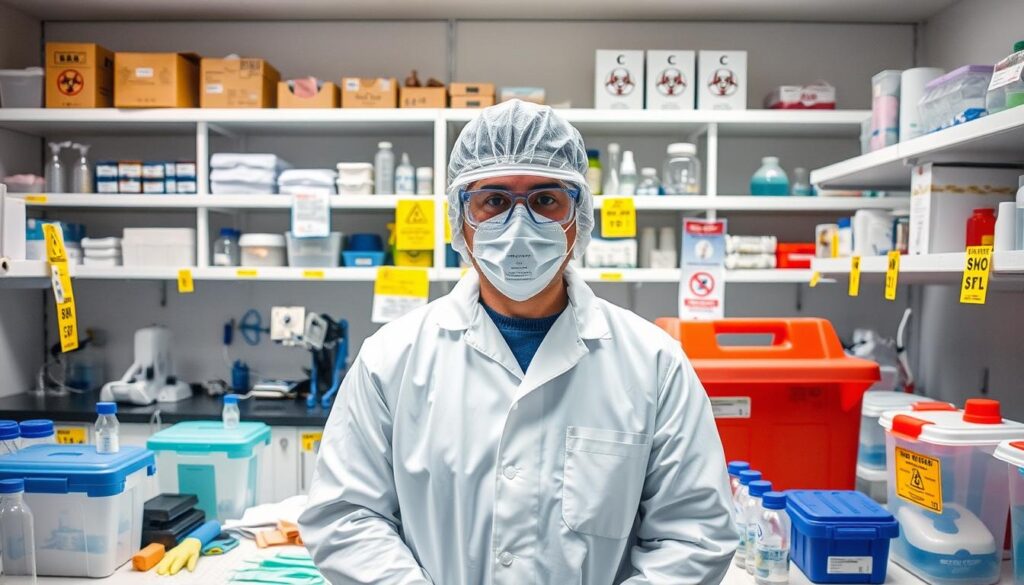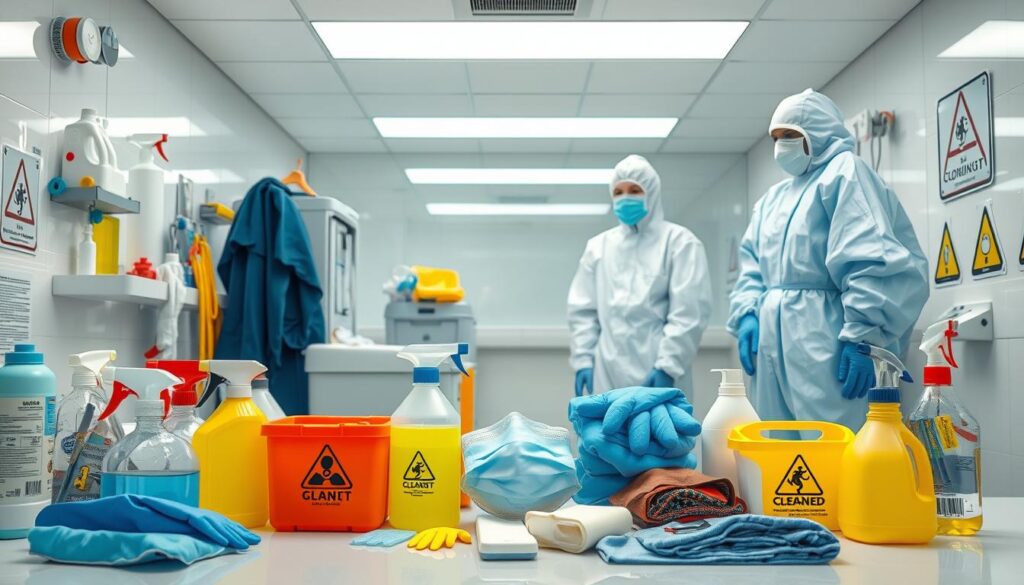
In today’s fast-paced world, strong biosecurity is more important than ever. Labs, research centers, and healthcare places face many dangers. These include harmful germs and bad actors. Knowing the common biosecurity mistakes and how to fix them is key.
This article will show you how to improve your biosecurity. You’ll learn to keep your team safe and protect your assets and the public. It’s all about staying safe in a world full of risks.
Key Takeaways
- Understand the importance of implementing effective biosecurity protocols in the modern world
- Identify and avoid the most common biosecurity mistakes, such as inadequate personal protective equipment (PPE) and improper decontamination procedures
- Learn about fundamental biosafety practices and essential pathogen containment measures
- Discover the critical role of personal protective equipment (PPE) as the first line of defense
- Explore proven decontamination procedures to maintain a safe working environment
- Implement robust laboratory safety measures to minimize risks
- Develop proactive biohazard management strategies, including risk assessment and emergency response planning
The Importance of Biosecurity in the Modern World
In today’s world, strong biosecurity protocols are more important than ever. Labs, research centers, and healthcare places face many challenges. These include new pathogens and the risk of accidents or misuse. Good biosecurity practices protect people, keep biohazards in check, and build trust.
It’s key to have strict laboratory safety rules. These rules help handle and store dangerous biological agents safely. Proper pathogen containment stops leaks or misuse. Also, good biohazard management plans help in emergencies and reduce damage.
Keeping a safe and watchful culture is vital in science today. By following the best biosecurity protocols, places can protect their workers, keep research safe, and gain public trust. It’s important to stay alert to new threats and improve biosecurity efforts.
| Biosecurity Aspect | Importance |
|---|---|
| Pathogen Containment | Prevents the accidental release or intentional misuse of hazardous biological agents. |
| Laboratory Safety | Protects personnel and ensures the secure handling of dangerous materials. |
| Biohazard Management | Enables proactive risk assessment and effective emergency response planning. |
“The true measure of a society is how it treats its most vulnerable members.”
By focusing on biosecurity, we can protect our scientists, keep people healthy, and encourage responsible innovation. We must stay alert and follow best practices to face the challenges of today and tomorrow.
Common Biosecurity Mistakes and How to Avoid Them
Keeping biosecurity strong is key to protecting health and the environment. Yet, even careful groups can make mistakes that weaken their defenses. We’ll look at two big areas where mistakes often happen: not using enough personal protective equipment (PPE) and not decontaminating properly.
Inadequate Personal Protective Equipment (PPE)
Good PPE is the first defense against germs. Without the right PPE, workers can get sick and spread germs. Mistakes include:
- Not giving the right PPE for the job or danger
- Not fitting, keeping, or replacing PPE right
- Not wearing PPE correctly, which can spread germs
To fix these problems, groups need to assess risks well, make clear PPE rules, and train workers well. This makes sure everyone knows how to use PPE right.
Improper Decontamination Procedures
Good decontamination stops germs from spreading and keeps places safe. But, bad decontamination can risk people and the environment. Issues include:
- Not using the right decontamination methods or agents
- Cleaning or sterilizing not enough or not right
- Not following decontamination rules well
To solve these problems, groups should make and follow strict decontamination steps. They should also train often and check quality to make sure everyone does things right.
Knowing these common mistakes and fixing them can make biosecurity stronger. This protects workers, the public, and the environment.
Biosafety Protocols: Fundamental Practices
Biosafety protocols are key to safe laboratory safety and biohazard management. They are crucial in any place that deals with dangerous materials. By focusing on safety, you protect your team and keep everyone healthy.
Good biosafety protocols start with solid training and clear rules. Everyone needs to know how to handle and dispose of dangerous stuff safely. They also need to know about safety tools and rules to keep the lab safe.
- Implement rigorous training programs for all staff members
- Develop and regularly update detailed standard operating procedures (SOPs)
- Ensure the availability and proper use of personal protective equipment (PPE)
- Establish effective decontamination and waste management processes
- Regularly review and update biosafety protocols to align with industry best practices
Creating a safe and compliant culture is vital. It helps reduce risks from biohazardous materials and keeps your lab safe. Strong biosafety protocols protect your team and uphold top laboratory safety standards.

| Key Elements of Biosafety Protocols | Description |
|---|---|
| Training and Procedures | Comprehensive training programs and detailed standard operating procedures (SOPs) for all personnel handling biohazardous materials. |
| Engineering Controls | Implementation of safety equipment, such as biosafety cabinets, to minimize exposure and contain potential accidents. |
| Administrative Measures | Establishment of policies, guidelines, and processes to ensure compliance and a culture of safety within the organization. |
| Personal Protective Equipment (PPE) | Provision and proper use of specialized PPE, such as lab coats, gloves, and goggles, to protect personnel. |
| Decontamination and Waste Management | Effective decontamination procedures and secure waste disposal methods to mitigate the spread of biohazards. |
Strong biosafety protocols make a safe place for your team. They help manage biohazardous materials well and keep laboratory safety high.
Pathogen Containment: Essential Measures
Effective pathogen containment is key to biosecurity. It stops the spread of harmful biological agents. This includes proper storage and handling and effective waste management. These steps help keep facilities safe and follow the rules.
Proper Storage and Handling
Keeping pathogens safe is crucial. It stops unauthorized access and prevents accidents. Important steps include:
- Using secure, special storage areas with limited access
- Keeping track of pathogen samples with strong inventory control
- Storing them in the right temperature and humidity
- Training staff well on handling dangerous materials
Effective Waste Management
Effective waste management is vital for pathogen containment. It handles biohazardous waste safely. Important parts are:
- Labeling and separating waste clearly
- Using methods like autoclaving or chemical treatment for decontamination
- Ensuring safe transport and disposal through licensed services
- Keeping detailed records of waste handling and disposal
By following these steps, organizations can improve their biosecurity. They protect their facilities, staff, and the community.
Personal Protective Equipment: Your First Line of Defense
In the world of laboratory safety and biosecurity, personal protective equipment (PPE) is key. It acts as a shield against biohazards. Choosing, using, and keeping PPE in good shape is vital to protect people and stop the spread of germs. This part talks about how important PPE is in keeping your lab safe.
Personal Protective Equipment is all about prevention. The right gear can greatly reduce the risks in Laboratory Safety and Biosafety Protocols. From gloves and gowns to eye and respiratory protection, good PPE blocks harmful substances.
Knowing how to put on and take off PPE correctly is also crucial. Doing it wrong can let in germs, defeating the purpose of the gear. By following the right steps, your PPE will keep you safe in the lab.
“Proper use of personal protective equipment is the first and most important step in preventing exposure to biohazards.”
Using Personal Protective Equipment is a must in your Biosafety Protocols and Decontamination Procedures. It helps keep your lab safe and responsible. By focusing on the right PPE, you build a solid base for Laboratory Safety. This protects you and your team from the dangers of working with harmful materials.
| Type of PPE | Purpose | Key Considerations |
|---|---|---|
| Gloves | Protect hands from contamination | Choose appropriate material and size, ensure proper fit, and replace regularly |
| Gowns/Coveralls | Protect body from splashes and spills | Select fluid-resistant and impermeable materials, ensure full coverage |
| Goggles/Face Shields | Protect eyes and face from splashes | Ensure clear, distortion-free vision and secure fit |
| Respirators | Protect respiratory system from airborne contaminants | Properly fit and maintain respirators, follow usage guidelines |
Decontamination Procedures: Maintaining a Safe Environment
Keeping any laboratory, research facility, or healthcare setting safe is crucial. This section will cover the basics of surface decontamination and equipment sterilization. You’ll learn how to lower the risk of pathogen spread and protect your team and space.
Surface Decontamination
Effective surface decontamination is key to a safe area. It means choosing the right disinfectants and following tested protocols. Regular checks and updates are also vital. By doing this, you can remove Decontamination Procedures and Biohazard Management worries, making your workspace clean and safe.
Equipment Sterilization
Proper Equipment Sterilization of lab and medical gear is also critical. This includes using proven methods like autoclaving or chemical disinfection. These steps help get rid of Biosafety Protocols and Biohazard Management risks. By sticking to these sterilization steps, you protect your space and people from Surface Decontamination dangers.
| Decontamination Procedure | Recommended Disinfectant | Exposure Time |
|---|---|---|
| Surface Decontamination | 70% Ethanol | 10 minutes |
| Equipment Sterilization | Autoclaving | 15 minutes at 121°C |

“Proper decontamination and sterilization procedures are the foundation of a safe and secure laboratory environment.”
Learning Surface Decontamination and Equipment Sterilization techniques is essential. It helps keep your environment safe and secure, reducing Biosafety Protocols and Biohazard Management risks.
Laboratory Safety: Minimizing Risks
Keeping a lab safe is key to a good biosecurity protocol. In the fast-paced world of science, it’s vital to reduce risks from dangerous materials and activities. This means using engineering controls, following administrative rules, and having strong training and emergency plans. A detailed approach helps build a safe and compliant lab environment that supports your biohazard management goals.
Risk assessment is at the core of lab safety. By carefully looking at potential dangers and setting up the right protections, you can lower risks in your lab. This includes checking your biosafety protocols, making sure everyone is trained, and staying up-to-date with new threats and methods.
- Use engineering controls, like biosafety cabinets, to keep hazardous materials safe.
- Set up detailed administrative procedures, including strict access rules, records, and incident reports.
- Make and update emergency plans often, so your team can quickly and well handle biosafety issues.
Creating a culture of safety, openness, and ongoing improvement is crucial. It ensures your lab not only meets top biosecurity standards but also helps science grow while keeping everyone safe.
Biohazard Management: Proactive Strategies
In the world of biosecurity, managing biohazards is key to keeping facilities safe and compliant. By using proactive strategies, companies can protect their people, assets, and the community around them.
Risk Assessment
Starting with thorough risk assessments is essential for a strong biohazard management plan. This step involves carefully looking at and understanding the risks of biohazardous materials. Knowing the risks helps organizations focus their efforts and use their resources wisely.
Emergency Response Plans
Along with risk assessments, creating detailed emergency response plans is vital. These plans show what to do in case of a biosecurity issue, like a pathogen leak or a containment breach. With a solid plan in place, companies can be ready and reduce the damage from any biosecurity emergencies.
| Biohazard Management Strategies | Key Benefits |
|---|---|
| Risk Assessment | Identifies and prioritizes potential biosecurity risks |
| Emergency Response Plans | Ensures preparedness and mitigates the impact of biosecurity incidents |
| Biosafety Protocols | Establishes standardized procedures for safe handling and containment of biohazards |
| Pathogen Containment | Implements robust measures to prevent the spread of hazardous pathogens |
By adopting proactive biohazard management, companies can lower risks, protect their operations, and help keep the biosecurity world safe and strong.
This article has covered common biosecurity mistakes and how to avoid them. By using strong biosafety protocols, improving pathogen containment, and wearing the right personal protective equipment, we can keep everyone safe. This makes sure our workplaces are secure and follow the rules.
Keeping biosecurity strong is a never-ending job. It needs constant watchfulness, bettering ourselves, and everyone working together for safety. Following the right decontamination procedures and sticking to laboratory safety rules helps a lot. This way, we can lower risks and keep our work areas safe.
The article also stressed the need for risk assessment and having good emergency response plans. These steps help us get ready and act fast in case of biosecurity problems. By following these tips, we can make our biohazard management better. This protects our work, people, and the community we help.